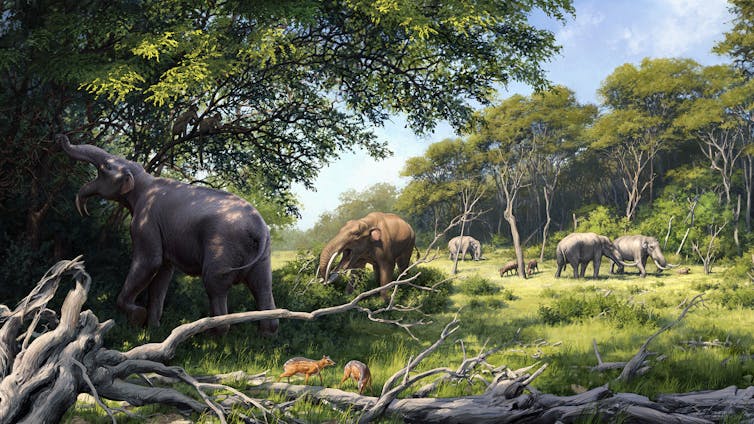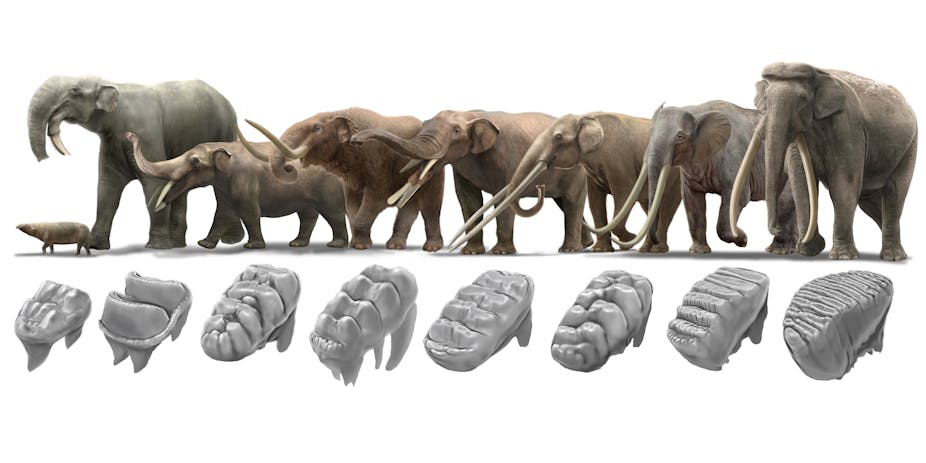Seeing elephants in the wild is a timelessly awe-inspiring experience. There are only three living species today: the African savannah elephant, African forest elephant, and Asian elephant.
They are the remnants of a once prosperous lineage of megaherbivores called proboscideans, whose evolutionary epic spanned 60 million years and some 200 species. The African continent was the centre stage of this story.
But, until now, it hasn’t been clear how natural selection favoured modern elephants as the only tiny surviving branch of proboscideans.
A new study by palaeontologists Juha Saarinen and Adrian Lister provides the answers. Lister supervised my PhD, which focused on evolutionary relationships of fossil elephants. Saarinen hosts my current postdoctoral position at the University of Helsinki, as we’re pursuing research stemming from these findings.
They focused on the emergence of elephants’ highly specialised, multi-plated cheek teeth from the primitive dentition of earlier proboscideans. Their conclusions demonstrate that behavioural adjustments in response to changing environments can produce sustained transformative trends in animals’ adaptive structures over tens of millions of years.
Teething problems
Modern elephants’ diets consist of copious amounts of tough, fibrous, often low-quality fodder. They’re able to eat this way because of their teeth: six massive grinding teeth per jaw half that erupt and expend sequentially in a horizontal “queue” throughout the animal’s life, each successively larger than the previous tooth. The adult molars are as big as bricks.
Enamel ridges that align longitudinally along the tooth shear up the vegetation like a cheese grater as the jaws move. These teeth also have high crowns that continuously erupt into position as the older chewing surface wears away, like lead pushing up in a mechanical pencil. This helps elephants deal with continuous tooth attrition from chewing.
The fossil record shows that, 20 million years ago, proboscidean teeth looked completely different. These teeth had rounded cusps aligned in pairs, versatile for chewing up a wide range of plant food in the primeval forests and thickets they inhabited. But they were ill-suited for tackling large quantities of tough, abrasive vegetation.
Scientists theorised that two major factors drove the evolution of wear-resistant dental features seen in elephants today. One was the spread of grass that could tolerate a cooler, drier and more seasonal climate than the cosy forest homes ancestral proboscideans occupied. The second was that large herbivores ingested more adhesive dust in these new arid environments than they had before.
Both challenges arose within the past 20 million years. But it wasn’t clear exactly how these two factors drove adaptive changes in herbivore teeth. The theory also presented a chicken-and-egg paradox: which took off first, the evolving teeth or the altered habitats?
The evidence
Saarinen devised a simple quantitative method to solve this conundrum. It’s founded on a basic mechanical principle. The way grazers eat wears the teeth flat, while browsers’ teeth have a more “edged” chewing surface. That means grazing elephants should develop angles of wear on their teeth that are wider than those of browsing elephants.
To test this idea, Saarinen first measured recent elephant teeth from Kenya’s Tsavo East National Park, which confirmed his initial postulation. He and Lister then turned to Africa’s wealth of geological and fossil records.

Their tooth wear measurements from fossils revealed that, about 21 million years ago, the first increase in dietary uptake of grass was achieved by the primitive “gomphothere”-type proboscideans of Africa. Gomphotheres were the generalised ancestral stock from which modern elephants and their other extinct relatives evolved.
Read more: From enormous elephants to tiny shrews: how mammals shape and are shaped by Africa's landscapes
They also discovered that these gomphotheres grazed more as grass cover expanded across their habitats between 21 million and 6 million years ago, as indicated by plant fossil fragments from the sites where the gomphothere teeth were found. Yet this was achieved with little structural evolution in their teeth.
This was a boom period for African proboscidean diversity. Habitats containing three or four proboscidean species were common. Some species adopted grazing to minimise competition with neighbouring pachyderms that preferred softer fodder.

Ultimate survivors
To scrutinise previously theorised links between climate, vegetation change and elephant evolution, Saarinen and Lister examined records from sediment cores drilled off Africa’s west and east coasts over previous decades. Those cores are essentially archives, capturing tens of millions of years of environmental changes on the continent. Arid periods are marked by dustier segments of the core.
Read more: Fossil tracks and trunk marks reveal signs of ancient elephants on South Africa's coast
Statistical testing of the data showed that the African environment began to get drastically more arid between 7 million and 5 million years ago, and this drove a vast increase in the rate of dental evolution in the lineage that gave rise to mammoths and modern elephants, as well as promoting the further spread of grasslands.
Thus came proof that the high-crowned, multi-plated molars of elephants evolved primarily to withstand grit, rather than fibre, in their food. This new dental form provided such an advantage that, around 3.6 million years ago, early elephants had outcompeted the last African gomphotheres into extinction.
New research avenues
The zenith of this evolutionary ratchet was Palaeoloxodon. It was the largest elephant to evolve, standing over 4 metres tall at the shoulder and weighing 12–15 tonnes. With brick-sized molars packing up to 21 grating plates, Palaeoloxodon was the undisputed top megaherbivore of the African savannah between 1.5 million and around 130,000 years ago, in both its stature and feeding adaptations.

Yet, within the last million years of our story, when African savannahs became increasingly arid and seasonal just as they did for the previous 5 million years, these spectacular grazing specialists vanished. Why?
Upon discussing his findings, Saarinen and I converged on a hypothesis. Modern African elephants are half the size of their prehistoric cousins, with teeth less specialised towards a grass-dominated diet. This may be key for elephants to tolerate the arid shrublands of today’s Africa, which have little grass cover to support such enormous grass-dependent vegetarians as Palaeoloxodon.
We’re examining this as part of our current research, hoping to decipher whether the encroachment of grasslands by shrubby arid zones drove the extinction of Palaeoloxodon and other spectacular giant herbivores in Africa over the past million years. The story we ultimately tell may serve as a stark warning for how climate change will further decimate African biodiversity, if it’s left unchecked.

